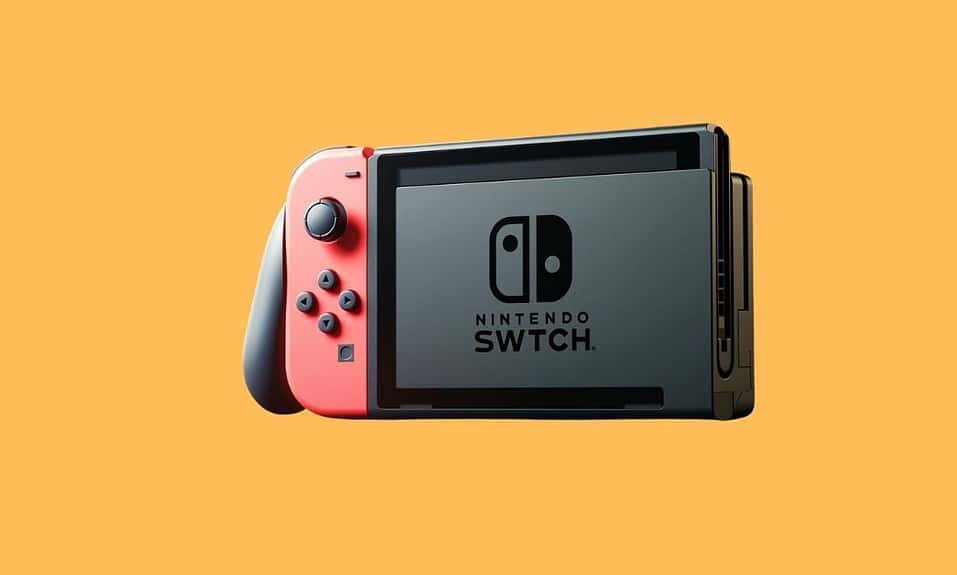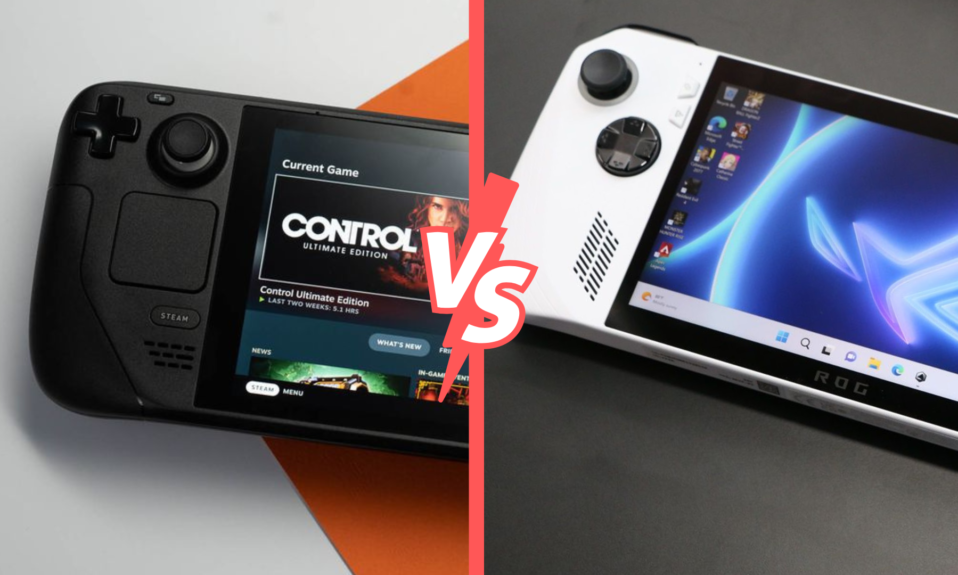Upscaling techniques are certainly one of the best tools that go to computer games. They are able to provide higher performance in your favorite title that supports it, without significantly losing the quality of the displayed image. Two big companies – NVIDIA and AMD – have them. The NVIDIA offer the DLSS technique, i.e. Deep Learning Super Sampling, and the AMD FSR – FidelityFX Super Resolution.
NVIDIA announced its solution much earlier, at the beginning of 2019, while AMD showed the world the first version of FSR much later, in the middle of 2021. During this time, both technologies have evolved significantly – DLSS is already available in version 3 (which is only for a few games – more titles support version 2.x). FidelityFX Super Resolution 2.0, on the other hand, made its debut relatively recently and began to appear in the first games from June. More and more game developers implement this technique for the next titles, and there are already a lot of them.
In early September, for example, it went to Red Dead Redemption 2, a popular game by Rockstar Games, responsible for the Grand Theft Auto series.
What is Upscaling?
Upscaling increases image, video, and audio resolution. This is done to improve content quality on devices with greater resolutions. Interpolation, pixel replication, and machine learning can upscale. Upscaling aims to maximise clarity and detail while minimising distortion and quality loss. Upscaling cannot add new content or details.
Difference: Nvidia DLSS vs AMD FSR
In terms of implementation, it should be noted that DLSS is limited to Nvidia GPUs, whereas FSR boasts compatibility with both AMD and Nvidia GPUs.
Compatibility: it can be noted that DLSS has a restricted number of games that support it, whereas FSR has a progressively expanding list of games that support it.
Performance: DLSS has been widely acknowledged as offering superior gains compared to FSR, thereby enabling gamers to attain elevated frame rates while preserving commendable visual fidelity.
The visual quality of DLSS has been subject to criticism due to its tendency to generate images that are blurry or washed-out. However, recent updates have led to a significant improvement in its performance. In contrast, the Foveated Spatial Resolution (FSR) technique has garnered acclaim for its capacity to uphold high visual fidelity despite reduced resolutions.
The DLSS algorithm employs artificial intelligence and machine learning techniques to enhance the resolution of game images, whereas FSR utilises a spatial upscaling algorithm that scrutinises the image and reconstructs it at an elevated resolution.
A minimum input resolution of 1080p is required for DLSS, whereas FSR can function with lower input resolutions.
DLSS has been accessible since 2018, whereas FSR was unveiled in 2021.
Both technologies have unique advantages and disadvantages. For higher input resolutions, DLSS provides superior performance enhancements and visual fidelity, whereas FSR provides greater compatibility and commendable visual quality. In the end, the choice between the two technologies may come down to personal preference as well as the games and hardware used.
In today’s article, we would like to test how both technologies work in RDR2 and, above all, how FSR 2.0 compares to DLSS. Without further ado, let’s move on to discussing the test platform.
Testing platform
- CPU 1: Intel Core i7-12700K processor
- Motherboard 1: 12th generation AORUS Z690 chipset
- GPU: GeForce RTX 3070
- RAM: 32 GB of DDR5-4800 RAM
- SSD: 4 TB of M.2 PCIe 4.0 NVMe SSD
We tested on the highest possible graphics settings, where each bar showed “Ultra” or “High” in two resolutions – 4K and 1440p.
NVIDIA DLSS vs AMD FSR 2.0 modes
AMD has made changes to their technology, including modes that are now available to users.The first version of Red upscaling had an Ultra Quality preset, but it’s not available now. In RDR2, there are only three options: no Ultra Performance.
AMD FSR 2.0
| Mode | Scaling | % of the rendered image | 3840 x 2160 | 2560 x 1440 |
| Quality | 1.5x | 66,(6) | 2560 x 1440p | 1920×1080 |
| Balance | 1.70x | 58.8 | 2258 x 1270 | 1505 x 847 |
| Efficiency | 2.0x | 50 | 1920×1080 | 1280×720 |
NVIDIA DLSS
| Mode | Scaling | % of rendered image | 3840 x 2160 | 2560 x 1440 |
| Quality | 1.5x | 66,(6) | 2560 x 1440p | 1920×1080 |
| balance | 1.72x | 58 | 2227 x 1253 | 1485 x 835 |
| Efficiency | 2x | 50 | 1920×1080 | 1280×720 |
| Ultra Performance | 3x | 33,(3) | 1280×720 | 853 x 480 |
Less resource consumption?
Interestingly, the techniques also have the effect of reducing video memory consumption, with the FSR needing much more VRAM. By default, in 4K resolution and maximum details, the game needs 5599 MB. After activating the individual presets, the memory usage is as follows:
- DLSS
- Quality: 4926MB,
- Balance: 4809MB,
- Capacity: 4654MB,
- Ultra performance: 4459 MB.
- FSR 2.0
- Quality: 5313MB,
- Balance: 5148MB,
- Performance 5066 MB.
At 1440p, things are a bit different, with the game consuming 4,753 MB by default, but with the upscaling techniques activated, the difference is also noticeable:
- DLSS
- Quality: 4414MB,
- Balance: 4356 MB,
- Capacity: 4291MB,
- Ultra performance: 4219 MB.
- FSR 2.0
- Quality: 4576MB,
- Balance: 4507 MB,
- 4437 MB.
On an 8GB graphics card these days it doesn’t really matter as there’s still a margin of headroom. However, the difference in use is significant – over 400 MB less for DLSS NVDII.
The RTX 3070 was not meant for 4K resolution, but it can still be tested at 3840 x 2160 pixels, which is the best option. Its intended use is for 1440p. I got 44 FPS at native resolution, and the image quality was amazing.
Sometimes having more frames per second is better, and in this case, having more than 60 FPS is even better.
Quality Comparison: 4K
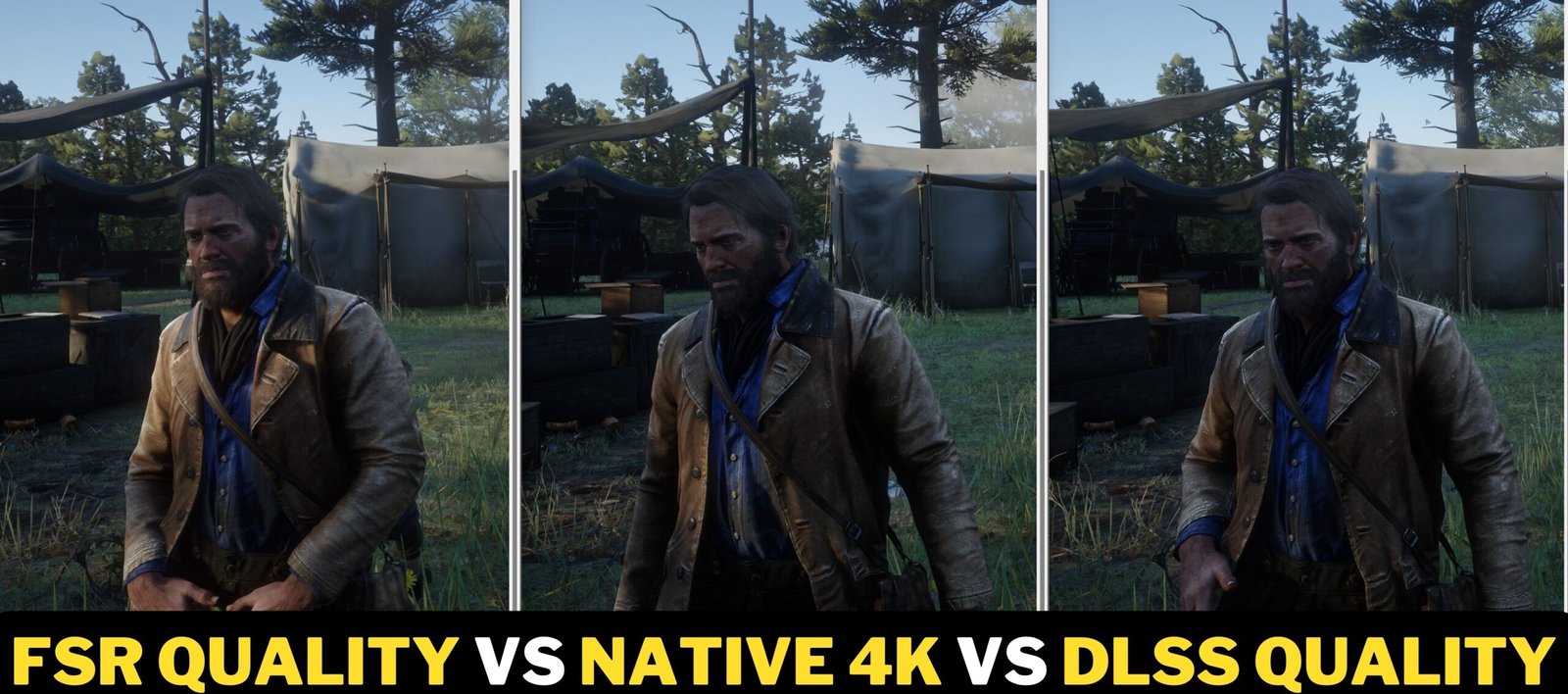

And here the upscaling technologies appear – DLSS and FSR 2.0 in quality mode, which we will use when we do not want to lose quality and we need a few more frames.
AMD technology guarantees 51 FPS, and NVIDIA – 52 FPS, i.e. the same performance.
How is the quality? Very well, whichever you choose, although in the scene above AMD did a better job of smoothing out the hair, but NVIDIA serves up a clearer, more detailed image.
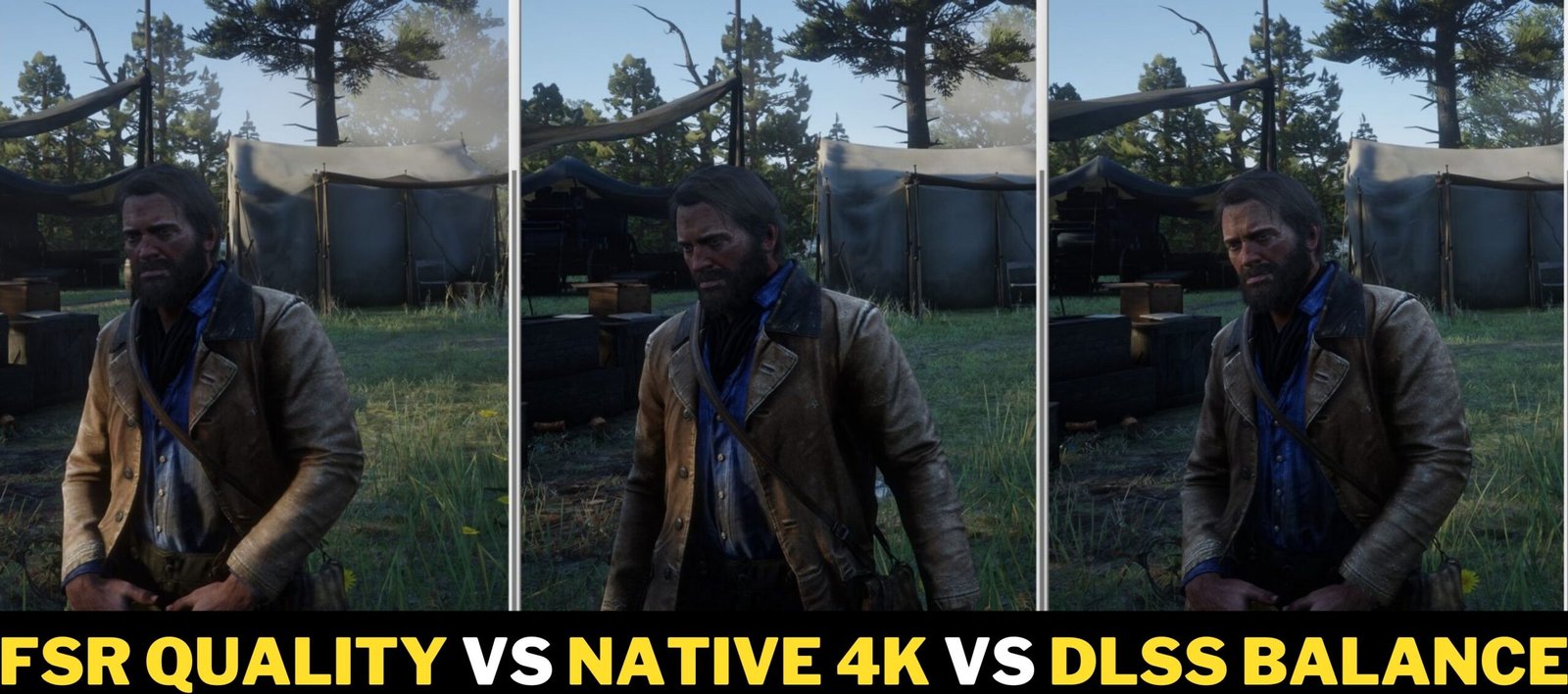
Some differences can already be seen in intermediate modes, where not only is NVIDIA providing a few FPS more than AMD on average, but the image quality is noticeably better. The technique of the Reds in the screenshot above apparently tries to compensate for the lack of details by smoothing the screen – which can be seen in the character’s face itself.
AMD still offers a good level of detail, but the image is even smoother – as you can see by looking at Arthur’s hands, face and hair.
Quality Comparison: 2K
The resolution of 2560 x 1440 pixels is much less resource-intensive than 4K, because the graphics card must generate more than 2 times less pixels, which confirms the performance. We have a base 70 FPS here, so with a graphics card like the GeForce RTX 3070, there is no need to run upscaling. Well, but the holders of weaker cards can already be tempted to do so.

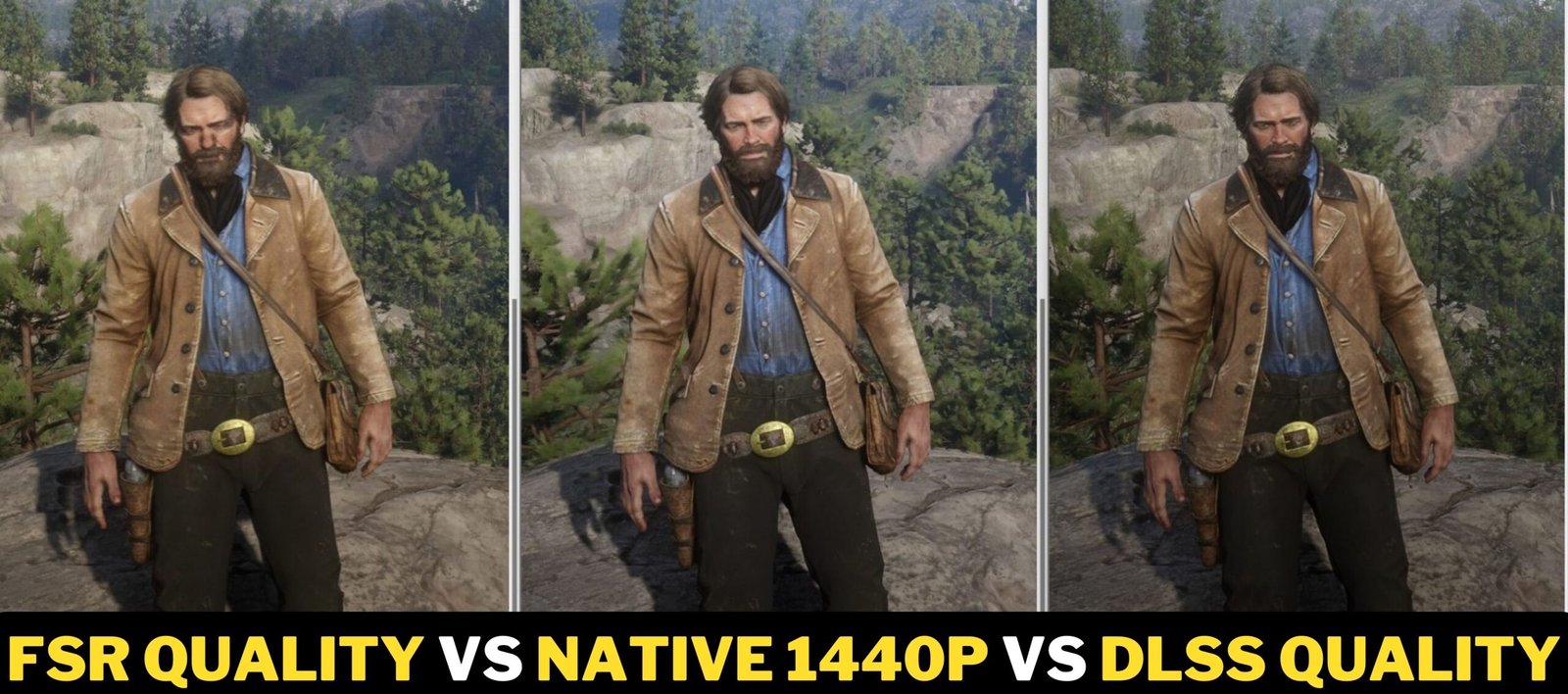
As you can see, in the case of upscaling to 1440p resolution, the difference between the AMD Technology Quality presets is already a significant difference. The character’s FSR face lacks detail, and anti-aliasing unfortunately no longer compensates for missing detail well.
How about performance? FSR provides an average of 77 FPS, while NVIDIA’s super sampling around 80, so again a win for the Greens.

Interestingly, in the intermediate (balance) modes, AMD’s detail smoothing gave an advantage over DLSS – where FSR 2.0 guarantees a quality closer to native resolution, but in terms of performance, NVIDIA did better here, guaranteeing about 85 FPS, and FSR allowed to get about 80FPS.

The situation repeats itself for performance modes – jagged hair is visible in the DLSS Performance prest, while in FSR 2.0 this has been greatly smoothed out. Looking at the unzoomed images, overall DLSS in performance mode provided a closer to native resolution.
Conclusion!
AMD did well. The new FSR is better than the first version. It makes better quality images that look more like DLSS and native resolution, especially at higher resolutions. FSR and NVIDIA’s super sampling have similar performance, but FSR performs slightly better.
DLSS is better than the competition because it uses hardware with Tensor cores and machine learning, which makes it faster and higher quality. This tool only works with GeForce RTX series cards – 2000, 3000, 4000. It won’t work with cards from other manufacturers. FSR is a free tool that can work on older Red graphics cards like RX 460, 470, 480, and newer systems like GTX 1000, RX 5000, and 6000.
Owners of GTX 1060, 1070, and 1080 can use FSR since DLSS is not available for these graphics cards. AMD Radeon users have only one solution. Should RTX users consider using dedicated DLSS technology? This makes things better and uses less resources, including video memory.
FSR 2.0 is better than the first version, but it’s not as good as DLSS. If you have an RTX card, there’s no reason to use FSR instead of DLSS. If you have an NVIDIA card and the game only offers FSR technology, consider turning it on. The quality is good, so use it.



